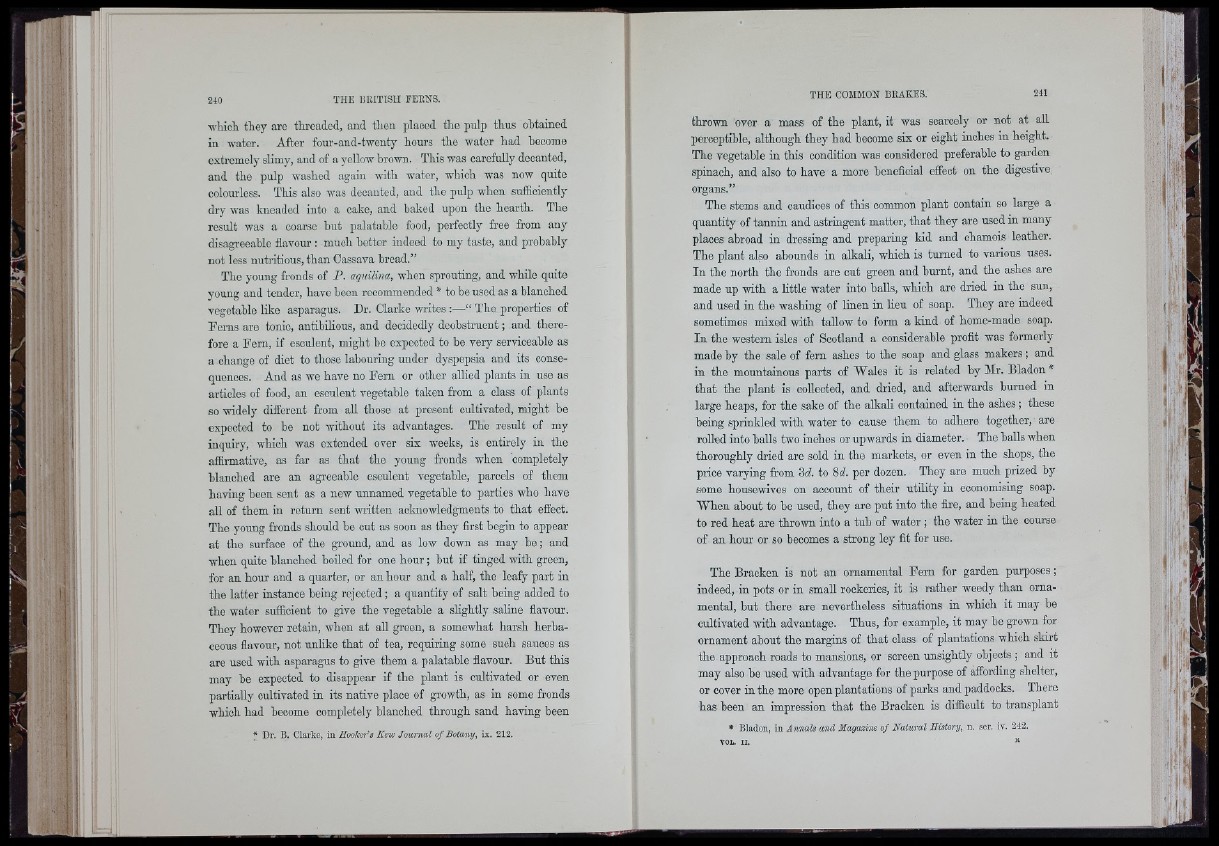
I
I k
li '-
V 4
ll"
¡Í'
ti i
titi
Í I
wliioli they aro threaded, and then placed the pulp thus obtained
in water. After four-and-twenty hours the water had become
extremely slimy, and of a yellow brown. This was carefully decanted,
and the pulp washed again with water, which was now quite
colomicss. This also was decanted, and tho pulp when sufficiently
dry was kneaded into a cake, and baked upon the hearth. The
result was a coarse but palatable food, perfectly free from any
disagreeable flavour : much better indeed to my taste, and probably
not less nutritious, than Cassava bread.”
Tho young fronds of P. aquilim, when sprouting, and while quite
young and tender, havo hcon recommended '* to bo used as a blanched
vegetable like asparagus. Dr. Clarke writes :—“ The properties of
Ferns are tonic, antibilious, and decidedly doobstruont; and therefore
a Fern, if esculent, might bo expected to he very serviceable as
a change of diet to those labouring under dyspepsia and its consequences.
And as we have no Fern or other allied plants iu use as
articles of food, an osoulont vegetable taken from a class of plants
so widely different from all tbose at present cultivated, might be
expected to bo not without its advantages. The result of my
inquiry, which was extended over six weeks, is entirely in tho
affirmative, as far as that the young fronds when completely
blanched are an agreeable esculent vegetable, parcels of them
having been sent as a new unnamed vegetable to parties who have
all of them in return sent written acknowledgments to that effect.
The young fronds should be cut as soon as they first begin to appear
at the surface of the ground, and as low down as may h e ; and
when quite blanched boiled for one hour; but if tinged with green,
for an hour and a quarter, or an hour and a half, the leafy part in
the latter instance heing rejected; a quantity of salt heing added to
the water sufficient to give the vegetable a shghtly saline flavour.
They however retain, when at aU green, a somewhat harsh herbaceous
flavour, not unlike that of tea, requiring some such sauces as
are used with asparagus to give them a palatable flavour. But this
may be expected to disappear if the plant is cultivated or even
partially cultivated in its native place of growth, as in some fronds
which had become completely blanched through sand having been
* Dr. B. Clarke, in Hooker's Kew Jo u rn a l o f Botany, ix. 212.
thrown over a mass of the plant, it was scarcely or not at all
perceptible, although they had become six or eight inches in height.
The vegetable in this condition was considered preferable to garden
spinach, and also to have a more beneficial effect on the digestive
organs.”
The stems and oaudioes of this common plant contain so large a
quantity of tannin and astringent matter, that they are used in many
places abroad in dressing and preparing kid and chamois leather.
The plant also abounds in alkali, which is turned to various uses.
In the north tho fronds are cut greeu and burnt, and the ashes are
made up with a Kttle water into balls, which are dried in the sun,
and used in the washing of Knen in lieu of soap. They are indeed
sometimes mixed with tallow to form a kind of home-made soap.
In the western isles of Scotland a considerable profit was formerly
made by the sale of fern ashes to the soap and glass makers ; and
in the mountainous parts of Wales it is related by Mr. Bladon*
that the plant is collected, and dried, aud afterwards burned in
large heaps, for the sake of the alkaK contained in the ashes ; these
heing sprinkled with water to cause them to adhere together, are
rolled into halls two inches or upwards in diameter. The balls when
thoroughly dried are sold in the markets, or even in the shops, the
price varying from 3Y. to 8d. per dozen. They are much prized by
some housewives on account of their utility in economising soap.
When about to he used, they are put into the fire, and being heated
to red heat are thrown into a tub of water ; the water in the course
of an hour or so becomes a strong ley fit for use.
The Bracken is not an ornamental Fern for garden purposes ;
indeed, iu pots or in smaU rockeries, it is rather weedy than ornamental,
but there are nevertheless situations in which it may be
cultivated with advantage. Thus, for example, it may he grown for
ornament about the margins of that class of plantations which skirt
the approach roads to mansions, or screen unsightly objects ; and it
may also he used with advantage for the purpose of affording shelter,
or cover in the more open plantations of parks and paddocks. There
has been an impression that the Bracken is difficult to transplant
* Bladon, in An n a ls and Magazine o f Na tu ra l History, n. ser. iv. 242.
VOL. II. ^
l A
' A li!
■|i
ñ
ill ki ■; I
I